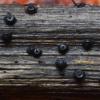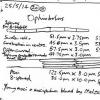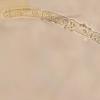
11-01-2026 20:35
Hello.A very tiny pyrenomycete sprouting sparsely

09-01-2026 17:41
Arnold BüschlenHallo, F. dilatata wird von vielen Bryoparasiten

10-01-2026 20:00
Tom SchrierHi all,We found picnidia on Protoparmeliopsis mur

07-01-2026 22:22
 Danny Newman
Danny Newman
Tatraea sp. on indet. hardwood The Swag, Great Sm

10-01-2026 01:18
 Danny Newman
Danny Newman
cf. Neovaginatispora fuckelii on indet. shrub Pre

07-01-2026 10:24
 Danny Newman
Danny Newman
Pezicula sp. on indet. hardwood Appalachian Highl

09-01-2026 10:08
 Blasco Rafael
Blasco Rafael
Hola, en el mismo habitat que la anteriorRetamaDia

08-01-2026 21:22
 Blasco Rafael
Blasco Rafael
Hola, He recogido esta muestra de Orbilia sobre Re

07-01-2026 17:29
 Marc Detollenaere
Marc Detollenaere
Dear Forum,On a barkless Populus I found some smal

10-11-2021 17:33
 Riet van Oosten
Riet van Oosten
Add-on topic http://www.ascofrance.com/forum/7059
Ophiobolus or Similar with Short Spores
Peter Thompson,
29-05-2014 15:16
I have found fruit bodies of what I assume to be a species from the genus Ophiobolus. They were growing on a damp, dead, undetermined, thin herbaceous stem and on drying, the fruit bodies have collapsed noticably.
The Shoemaker 1976 paper does not seem to contain a species matching the characteristics of mine. I notice some clear similarities between the shape and structure of the spores of my sample and those of the 16th May 2012 forum post by Enrique Rubio, (which was concluded to be an undescribed species). In mine though, the partly swollen cell is at the centre of the much shorter spores.
I have attached an image of the fruit bodies and a sketch of the microscopy. I imagine that it will turn out to be another undescribed species, unless anyone can identify it.
Thank you,
With Best Wishes,
Peter.
Enrique Rubio,
29-05-2014 17:07
Peter Thompson,
29-05-2014 18:01
Re : Ophiobolus or Similar with Short Spores
Hello Enrique,
Thanks for your reply.
I am wondering if my find is different, because of the position of the swollen cell right in the centre of the spore. I am seeing both 5-septate and 6-septate spores, which, I think are shorter than yours.
With Best Wishes,
Peter.
Thanks for your reply.
I am wondering if my find is different, because of the position of the swollen cell right in the centre of the spore. I am seeing both 5-septate and 6-septate spores, which, I think are shorter than yours.
With Best Wishes,
Peter.


